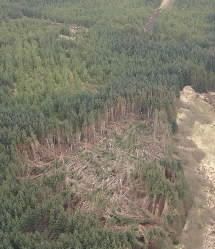Summary
 This project aims to develop a prototype integrated optimal rotation length model. The model is integrated in the sense that it accounts for timber production, climate change mitigation in terms of carbon sequestration and substitution benefits, and climate change adaptation in relation to windthrow risks.
This project aims to develop a prototype integrated optimal rotation length model. The model is integrated in the sense that it accounts for timber production, climate change mitigation in terms of carbon sequestration and substitution benefits, and climate change adaptation in relation to windthrow risks.
Research objectives
- Develop a prototype optimal rotation length model that accounts for timber production, climate change risks (focusing initially upon wind risks) and carbon sequestration.
- Apply existing Forest Research (FR) models of carbon balances in forestry and of wind risk.
- Explore critical factors affecting rotation length decisions with landowners and forest managers as a means to inform model design.
Results
 The prototype model yields results which behave in agreement with theory. For example, an increase in the price of timber would lead to a reduction in the optimal rotation length.
The prototype model yields results which behave in agreement with theory. For example, an increase in the price of timber would lead to a reduction in the optimal rotation length.- Currently the model has been tested primarily for the case of unthinned Sitka spruce.
- For sites with low windthrow risk the optimal rotation length is very sensitive to the price placed on the carbon sequestered. At prices around and above £5/tCO2e the model suggests that the optimal harvesting decision is not to harvest at all.
- At sites with low windthrow risk changing the discount rate has a moderate impact on the optimal rotation length: for a reduction in the rate from 3.5% to 1% the optimal rotation length increases by about 5 years.
- At windy sites, increasing windthrow risk is a major determining
 factor of the optimal rotation length in cases where windthrown timber is of no value due to the salvage costs and lower commercial value of snapped and snagged trees.
factor of the optimal rotation length in cases where windthrown timber is of no value due to the salvage costs and lower commercial value of snapped and snagged trees. - Recommendations are made for future research and model development.
Final report published in December 2017
Status
Project started in 2012 and it’s now completed
Contact
Funders and partners
Forestry Commission funded, Economics Programme
